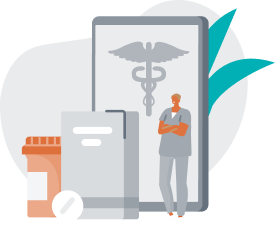Pemphigus vulgaris and bullous pemphigoid are two autoimmune skin conditions that can look similar on the surface, but they’re actually quite different beneath the skin.
Both cause blisters, but they develop for different reasons and often affect different age groups.
Knowing the difference between these conditions matters because they’re treated in different ways. Understanding your own condition better can also help you take better care of yourself and your health.
Pemphigus Vulgaris and Bullous Pemphigoid 101
Pemphigus vulgaris and bullous pemphigoid are both autoimmune skin conditions that cause blisters, but they’re not the same. Each one affects the skin differently, and knowing the difference is key to getting the right diagnosis and care.
Pemphigus vulgaris is a rare condition where the body’s immune system attacks the proteins that help skin cells stick together. This causes fragile, painful blisters that often begin in the mouth and can spread to the skin.
Bullous pemphigoid, on the other hand, happens when the immune system targets the layer between the top and bottom parts of the skin. This leads to firm, itchy blisters that are more resistant to breaking. It’s more common in older adults, especially those over 60.
How Common Are These Conditions?
Both pemphigus vulgaris and bullous pemphigoid are considered rare, but bullous pemphigoid is seen more often.
Pemphigus vulgaris affects about 1 to 5 people per million each year.
Bullous pemphigoid is slightly more common, with around 7 to 14 cases per million people annually.
Although these numbers are low, it’s important to remember that you’re not alone, and effective treatments are available. With the right diagnosis and a care team that understands your condition, it’s possible to manage symptoms and protect your skin.
Causes and Risk Factors
Autoimmune skin conditions like pemphigus vulgaris and bullous pemphigoid can be confusing to come to grips with when you’re first diagnosed. Understanding what causes them—and who’s more at risk—can help you feel more informed and supported on your care journey.
Pemphigus Vulgaris
What’s happening in the body?
Pemphigus vulgaris is a rare autoimmune condition where your body’s immune system creates antibodies that attack desmogleins—proteins that help skin cells stick together. When these proteins are damaged, the layers of your skin separate, causing fragile, painful blisters. These blisters often start in the mouth before appearing on the skin.
Risk factors may include:
- Age: Most often affects adults between 30 and 60.
- Genetics: Certain genes, including specific HLA types, may increase your risk.
- Environmental triggers: In some cases, things like medications, infections, or UV light may trigger symptoms.
Bullous Pemphigoid
What’s happening in the body?
In bullous pemphigoid, your immune system targets two different proteins—BP180 and BP230—that anchor the top layer of your skin to the layers underneath. When these proteins are attacked, the skin lifts and forms deeper, more durable blisters that tend to itch rather than hurt.
Risk factors may include:
- Age: Most common in people over 60.
- Other health conditions: Sometimes associated with neurological diseases like Parkinson’s or dementia.
- Medications or environmental triggers: Certain medications and external factors may play a role in triggering the condition.
Comparing Signs and Symptoms
While both pemphigus vulgaris and bullous pemphigoid cause blisters, the way these blisters look, feel, and show up on the body can be quite different. Knowing what to look for can help you and your care team better understand what’s going on and find the right treatment plan.
Where Symptoms Show Up
Pemphigus vulgaris often starts in the mouth, with painful sores that can make eating and talking uncomfortable. These sores may appear before any skin symptoms. When blisters form on the skin, they tend to be fragile and break easily, often leaving raw, sensitive areas behind.
Bullous pemphigoid, on the other hand, typically doesn’t affect the mouth. Instead, it causes larger, firmer blisters that appear on areas like the lower belly, upper thighs, and skin folds. These blisters tend to stay intact longer and are usually less painful.
What the Blisters Look Like
Pemphigus vulgaris blisters are shallow and delicate. They’re more likely to burst on their own, which can lead to open, sore areas that take time to heal.
Bullous pemphigoid blisters form deeper under the skin. They’re firmer, more raised, and less likely to pop on their own, which can help prevent infection and promote healing.
How They Feel
The discomfort also differs between the two:
Pemphigus vulgaris is often painful, especially when blisters burst and leave exposed skin behind.
Bullous pemphigoid usually causes intense itching. While it may be less painful, the itch can still affect daily life and sleep.
In some cases, providers might perform a skin test called the Nikolsky sign, where gentle pressure on the skin causes it to peel away. This is more common in pemphigus vulgaris and helps distinguish it from bullous pemphigoid.
How Pemphigus Vulgaris and Bullous Pemphigoid Are Diagnosed
With the right medical team and the right tools, you can get answers and start moving toward effective treatment. Diagnosis typically involves a few steps, including a physical exam, a skin biopsy, and lab tests.
What Providers Look For During a Physical Exam
Your dermatologist will start by carefully examining your skin—and possibly your mouth or other mucous membranes—for signs that point to one condition or the other.
The location, size, and type of blisters can offer important clues. They may also ask about your health history, including whether you’ve had other autoimmune conditions or taken any medications that could be linked to these symptoms.
Skin Biopsies
A skin biopsy is a key part of diagnosing these conditions. It involves taking a small sample of your skin and looking at it under a microscope. Here’s what they’re looking for:
Pemphigus vulgaris: The skin layers separate within the upper part of the skin (the epidermis), a process called acantholysis.
Bullous pemphigoid: The split happens a little deeper, between the outer layer of skin (epidermis) and the layer beneath it (dermis), which causes more intact, firm blisters.
Lab Tests
To get even more detailed information, your care team may use special lab tests that check for certain autoantibodies—proteins made by the immune system that mistakenly attack healthy skin.
- Direct immunofluorescence (DIF) looks at a sample of your skin and shows how and where these autoantibodies are behaving.
- In pemphigus vulgaris, it often shows a “chicken wire” pattern where the autoantibodies sit between skin cells.
- In bullous pemphigoid, it usually shows a straight line of antibodies along the layer between the skin and the tissue below it.
- Blood tests like ELISA (enzyme-linked immunosorbent assay) can detect specific autoantibodies in your bloodstream:
- Pemphigus vulgaris is linked to antibodies against desmoglein proteins.
- Bullous pemphigoid is often associated with antibodies against BP180 and BP230 proteins.
Treatment Options for Pemphigus Vulgaris and Bullous Pemphigoid
Managing these autoimmune blistering diseases involves suppressing the immune system and controlling symptoms.
Treatment for Pemphigus Vulgaris
Managing pemphigus vulgaris focuses on calming the immune system, reducing symptoms, and supporting healing. With the right treatment, many people see major improvements, and CSP is here to help guide your care.
Common Medications
Most people begin with oral corticosteroids like prednisone to reduce inflammation. To limit long-term steroid use, providers often add steroid-sparing medications such as:
- Azathioprine
- Mycophenolate mofetil
- Rituximab, a targeted therapy that lowers harmful antibodies
Ongoing Care
Long-term support includes:
- Regular check-ins to monitor progress
- Wound care and pain management
- Nutrition support, especially if mouth sores affect eating
If needed, IVIG therapy may be added for more advanced cases. CSP offers specialty infusion services to help make treatment easier.
Treatment for Bullous Pemphigoid
Treatment for bullous pemphigoid is focused on controlling symptoms and promoting skin healing, especially in older adults who may have other health concerns.
Common Medications
Initial treatment often includes:
- Topical corticosteroids for milder symptoms
- Oral corticosteroids for more widespread cases
Some may need immune-suppressing medications or biologic therapies if symptoms persist.
Ongoing Care
Ongoing care includes:
- Symptom relief for itching and discomfort
- Skin protection and gentle wound care
- Regular monitoring and adjustments to treatment
In more complex cases, IVIG may be an option, supported by CSP’s infusion therapy services.
Moving Forward With an Autoimmune Blistering Disease
Pemphigus vulgaris and bullous pemphigoid are rare, but serious, autoimmune skin conditions. While both cause blisters, they differ in how they show up, how they’re diagnosed, and how they’re treated. Understanding these differences is key to getting the right care and managing symptoms effectively.
At California Specialty Pharmacy, we know these conditions can be overwhelming, but you’re not alone. Our team is here to support you with expert medication management, gentle skin care guidance, and compassionate, personalized treatment. We’ll work closely with your dermatology and rheumatology specialists to make sure your care plan fits your unique needs.
With the right treatment and ongoing support, many people with pemphigus vulgaris or bullous pemphigoid can achieve long-term remission and feel more like themselves again.
Need help managing your condition? CSP’s infusion team is here for you every step of the way. Contact us today to start your treatment journey.
Frequently Asked Questions (FAQ):
What is the difference between pemphigus vulgaris and bullous pemphigoid?
Pemphigus vulgaris usually causes painful, fragile blisters that often start in the mouth. Bullous pemphigoid leads to firm, itchy blisters on the skin that don’t break as easily and rarely involve the mouth.
What are 2 signs of pemphigus vulgaris?
Painful blisters on the mucous membranes—especially the mouth—and a positive Nikolsky sign, where gentle pressure causes the skin to peel, are common signs.
How to remember pemphigus vs pemphigoid?
Pemphigus causes fragile blisters and affects the mouth. Bullous pemphigoid causes tougher, itchy blisters that usually spare the mouth.
What is the difference between pemphigus vulgaris and mucous membrane pemphigoid?
Pemphigus vulgaris causes shallow blisters on both the skin and mucous membranes. Mucous membrane pemphigoid mainly affects areas like the mouth or eyes with deeper, more persistent blisters.
References:
- Di Lernia V, Casanova DM, Goldust M, Ricci C. Pemphigus Vulgaris and Bullous Pemphigoid: Update on Diagnosis and Treatment. Dermatol Pract Concept. 2020 Jun 29;10(3):e2020050. https://pmc.ncbi.nlm.nih.gov/articles/PMC7319750/
- Aslam A. Bullous pemphigoid and pemphigus vulgaris. BMJ. 2017;357:j2169. https://www.bmj.com/content/357/bmj.j2169
- Skin Biopsy. Mayo Clinic. 2025 Mar. https://www.mayoclinic.org/tests-procedures/skin-biopsy/about/pac-20384634
Legal Disclaimer: The content provided on this blog is for informational purposes only and is not intended to serve as medical advice, diagnosis, or treatment. While we make every effort to provide accurate and up-to-date information, the details shared here should not be considered a substitute for professional medical consultation or advice.
By accessing this blog, you agree to hold harmless the author, publisher, and any associated parties from any claims, liabilities, or damages arising from the use or interpretation of this content.
©2025 California Specialty Pharmacy, LLC. All rights reserved.

